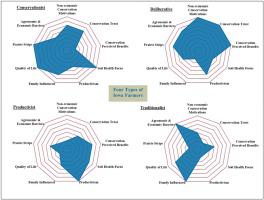当前位置:
X-MOL 学术
›
Land Use Policy
›
论文详情
Our official English website, www.x-mol.net, welcomes your
feedback! (Note: you will need to create a separate account there.)
Developing farmer typologies to inform conservation outreach in agricultural landscapes
Land Use Policy ( IF 6.0 ) Pub Date : 2021-02-01 , DOI: 10.1016/j.landusepol.2020.105157 Suraj Upadhaya , J. Gordon Arbuckle , Lisa A. Schulte
Land Use Policy ( IF 6.0 ) Pub Date : 2021-02-01 , DOI: 10.1016/j.landusepol.2020.105157 Suraj Upadhaya , J. Gordon Arbuckle , Lisa A. Schulte

|
Abstract Understanding factors that motivate conservation behavior among farmers is crucial to addressing societal, soil, water, and wildlife conservation goals. Farmers employ soil conservation practices to maintain agricultural productivity while minimizing impacts to water and wildlife in the long-term. The majority of conservation programs are voluntary in nature and some farmers are more willing and/or able to implement conservation practices than others. To inform the development of more effective conservation outreach and incentive programs, we created a farmer typology using data from three waves (2015, 2016, 2018) of a longitudinal survey of 358 farmers from Iowa, a highly productive agricultural state in the U.S. Midwest. Using multivariate analysis (Principal Component Analysis, and Cluster Analysis), we employed 26 summated scale variables measuring largely unobservable and latent constructs related to conservation, including awareness, attitudes, beliefs, and perceived motivations and barriers to practice adoption. Through this analysis, we identified four types of farmers-Conservationist, Deliberative, Productivist, and Traditionalist—based on the salient characteristics of each group. “Conservationist” farmers scored highest on measures of stewardship motivations and identity. “Deliberative” farmers appeared to be favorably disposed toward conservation, but also seem to consider agronomic and economic impediments more than other groups. “Productivist” farmers had the highest scores on profit motivation and emphasis on input use. “Traditionalist” farmers reported being heavily influenced by family members and scored highest on social and regulatory influence on conservation motivations. Detailed understanding of between-groups differences on key conservation-related factors can contribute to developing targeted messages for specific subgroups of a given population, potentially resulting in higher adoption of voluntary conservation programs in Iowa and beyond.
中文翻译:

开发农民类型以告知农业景观的保护外展
摘要 了解激发农民保护行为的因素对于实现社会、土壤、水和野生动物保护目标至关重要。农民采用土壤保持措施来保持农业生产力,同时最大限度地减少对水和野生动物的长期影响。大多数保护计划本质上是自愿的,一些农民比其他人更愿意和/或能够实施保护措施。为了制定更有效的保护外展和激励计划,我们使用来自爱荷华州(美国中西部一个高产农业州)的 358 名农民的纵向调查的三波(2015 年、2016 年、2018 年)的数据创建了农民类型学。使用多变量分析(主成分分析和聚类分析),我们采用了 26 个汇总的尺度变量来衡量与保护相关的大部分不可观察和潜在的结构,包括意识、态度、信念以及感知的动机和实践采用的障碍。通过这项分析,我们根据每个群体的显着特征确定了四种类型的农民——保护主义者、协商主义者、生产主义者和传统主义者。“环保主义者”农民在管理动机和身份的衡量标准上得分最高。“深思熟虑”的农民似乎更倾向于保护,但似乎也比其他群体更多地考虑农艺和经济障碍。“生产主义”农民在利润动机和对投入品使用的重视方面得分最高。“传统主义”农民报告说,他们深受家庭成员的影响,在社会和监管对保护动机的影响方面得分最高。对关键保护相关因素的群体间差异的详细了解有助于为特定人群的特定亚群制定有针对性的信息,从而可能导致爱荷华州及其他地区更多地采用自愿保护计划。
更新日期:2021-02-01
中文翻译:

开发农民类型以告知农业景观的保护外展
摘要 了解激发农民保护行为的因素对于实现社会、土壤、水和野生动物保护目标至关重要。农民采用土壤保持措施来保持农业生产力,同时最大限度地减少对水和野生动物的长期影响。大多数保护计划本质上是自愿的,一些农民比其他人更愿意和/或能够实施保护措施。为了制定更有效的保护外展和激励计划,我们使用来自爱荷华州(美国中西部一个高产农业州)的 358 名农民的纵向调查的三波(2015 年、2016 年、2018 年)的数据创建了农民类型学。使用多变量分析(主成分分析和聚类分析),我们采用了 26 个汇总的尺度变量来衡量与保护相关的大部分不可观察和潜在的结构,包括意识、态度、信念以及感知的动机和实践采用的障碍。通过这项分析,我们根据每个群体的显着特征确定了四种类型的农民——保护主义者、协商主义者、生产主义者和传统主义者。“环保主义者”农民在管理动机和身份的衡量标准上得分最高。“深思熟虑”的农民似乎更倾向于保护,但似乎也比其他群体更多地考虑农艺和经济障碍。“生产主义”农民在利润动机和对投入品使用的重视方面得分最高。“传统主义”农民报告说,他们深受家庭成员的影响,在社会和监管对保护动机的影响方面得分最高。对关键保护相关因素的群体间差异的详细了解有助于为特定人群的特定亚群制定有针对性的信息,从而可能导致爱荷华州及其他地区更多地采用自愿保护计划。











































 京公网安备 11010802027423号
京公网安备 11010802027423号